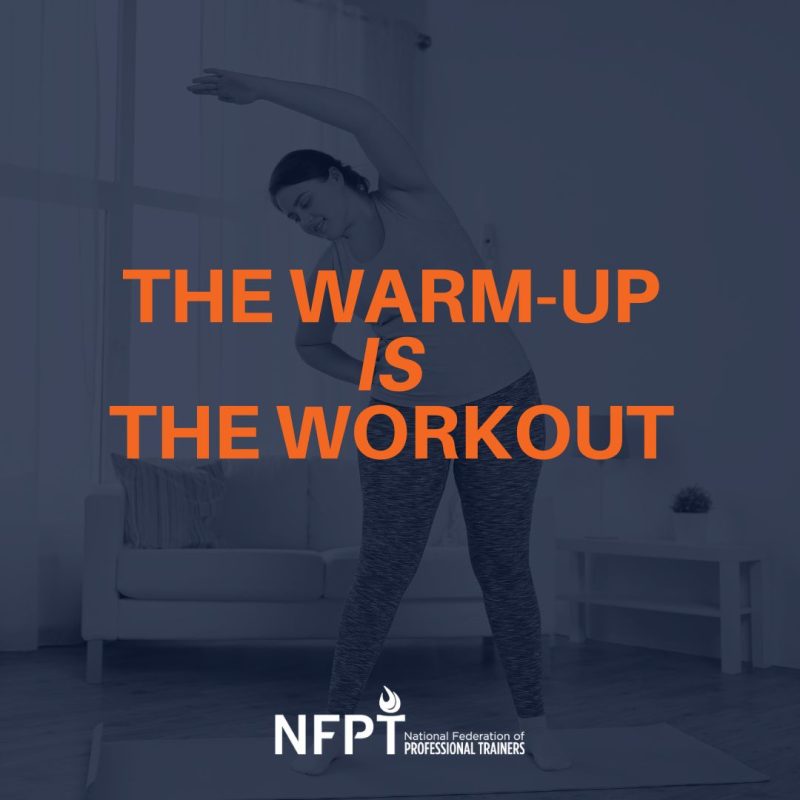
For many of our personal training clients, the one area of training that should not be overlooked or undervalued is the warm-up. When everyone feels pressed for time, the warm-up is easy to dismiss or, worse, skipped altogether–especially if a client is running late. I think we’ve all been there and it’s tempting to appease the client by scrapping the warmup and just “getting after it”, considering there is only so much time in a workout session and there may be a lot to cover. As tempting as it is to skip the warm-up or haphazardly run through it quickly, you are running the risk of injury to save time; this is not the answer.
Instead, make the warm-up “Act 1” of the workout and simply the opening credits. As certified personal trainers, we must exercise due diligence on our clients’ behalf.
First, do no harm. Keep your clients’ safety ahead of perceived progress and intensity. A client who gets injured while working with you may have a hard time trusting your process.
Second, help clients achieve greater results, become stronger, more injury-resistant, athletic, etc. The warm-up is where it starts and is frankly necessary to prepare the body for exercise. Without proper blood flow into our muscles and dynamic, preparatory movements, injuries are more likely to occur.
Types of Warm-ups
The most common type of warm-up (which I used to believe was effective and enough) is to have clients get their heart rate up on some piece of cardio equipment like the treadmill or elliptical for 5 minutes. Though there is benefit to increasing tissue temperature and heart rate, these condintions are not adequate on their own, failing to prepare the body for the demands of the strength portion of the workout.
Another common approach to warming up would be to just start a workout with lighter sets of a given exercise (like bodybuilders have done for decades) and then build up to working (heavier) sets. This also offers some benefit, but is still missing the key components of a solid, appropriate warm-up for your personal training clients.
The ideal warm-up would involve approaching it the same as you would your workout programming. What is the goal? What does this person need more of in order to achieve better results? The universal goal is to improve all-around movement and prepare the body for more intense exercise.
Here’s what takes place with this type of warm-up:
- Increase tissue temperature (which enhances the muscular system)
- Prepare the central nervous system (CNS)
- “Prime” and improve mobility
- Rehearse and improve overall movement patterns
- Activate certain muscles to improve stability
The Necessary Components of an Ideal Warm-Up
Let’s break down what each of these is and why they are important to have in the warm-up.
1) Increase tissue temperature (which enhances the muscular system)
This is the most common shared characteristic of pretty much any warm-up; it’s simply getting your heart rate up and the body warmer. Anytime you do this your muscles are increasing tissue extensibility which will allow for greater contraction and dynamic movements.
2) Prepare the central nervous system (CNS)
The CNS gets to decide what muscles fire, how strong and fast they are, how far they will elongate, what motor patterns and postures you adopt, and whether you will experience pain – in short, everything that matters.
3) “Prime” and improve mobility
One of the main reasons the warm-up is so important is to improve mobility and overall movement. Most people need more ankle, hip, and thoracic (upper back) mobility. It is imperative to get synovial fluid into the joints, lubricating them, and thus allowing for better mobility throughout a workout.
4) Rehearse and improve overall movement patterns
Depending on which exercises are in the strength portion of the workout, performing similar movements in the warmup is beneficial. If the workout calls for deadlifts, for example, doing hip hinges and lighter variations of deadlifts beforehand will get the body ready for working sets of deadlifts. Simply jumping right into heavy sets of deadlifts would not be prudent.
5) Activate muscles to improve stability
While some may say these exercises look more like rehab than training, including exercises such as glute bridges, mini band lateral steps, and band pull-aparts promote muscle activation, waking up muscles that are often weak links or perhaps not trained at all. Remember that most people sit too much, develop rounded shoulders and weak core musculature; muscles get “sleepy” –this is why we want to “wake” them up.
Sample Warm-Up
While the warm-up is certainly individualized and should be tailored to meet the needs of where each person is at, here is a sample of what covers most bases for clients that include
Foam Roll (soft tissue work)
Foam-rolling or self-myofascial release (SMR) not only brings blood flow to the area, but helps to release tension, and potentially reduce delayed onset muscle soreness (DOMS). Prime areas to focus on include calves, hamstrings, quads, glutes, upper back, and inner thighs. However, a proper assessment of your client should indicate if additional areas of concern are worth prioritizing.
Dynamic Stretching
Static stretching will likely reduce power output and is only ever necessary for an overactive or excessively short muscle. Instead, employ dynamic stretching in which the client is moved through a full range of motion. Some movements to include:
Inchworms
90/90 for hips
Walking lunges
Prisoner squats
Shoulder circles
Or the world’s greatest warm-up (and variations of such). Remember, you are responsible for tailoring specifics for the client you are working with:
Muscle Activation
This might include corrective exercises and movement from the ground-up and a gradual buildup of movement intensity:
5 Each:
leg lowering
single leg glute bridges
hip hinges
10 shoulder raises
10 mini band lateral steps
15 band pull-aparts
Heart Rate Elevators and Activators:
stairs down and back x 2
30 seal jacks (clap in front, rather than overhead)
Marching/Toy Soldier
Take-Home
If you are pressed for time in the workout, do not devalue the warm-up, instead tweak the workout portion to meet your clients’ needs. World-renowned strength coach, Dan John says the warm-up is your workout and I tend to agree. The warmup is important if not more important because injury reduction and better results for clients will keep them paying customers for the long haul. Hopefully, after reading this article, you will look at warming up differently and start to incorporate the different aspects instead of just warming up for 5 minutes on the elliptical. Remember the warm-up is the start of the workout.
References
Boyle, Michael. 2010. Advances in functional movement







